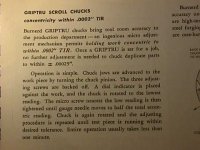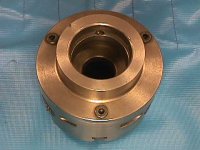Froneck
Titanium
- Joined
- Dec 4, 2010
- Location
- McClure, PA 17059
Picked up a set true 8" 3 jaw chuck at HGR a while ago. One piece jaws and don't have the reverse jaw set. Have other chucks, not set true but the jaws on the chuck are correct for what I'm doing. L-0 back plate that looks factory installed.
This set true is not as most set true adjustments are. I have others that fit D1-6 spindle lathe that have 4 flat bottom large diameter set set screws that push against the back plate that has mounting holes larger to allow movement.
This chuck doe not have that type, only 3 adjusters. center of about a 4" long adjuster fits in a hole behind each of the 3 jaws. Adjuster accepts 3/8 hex wrench, has slight taper about 1-1/2 long and threaded 3/8-16
I loosened all 3 (very loose) since the item chucked was running .005TIR out, tightened the one behind the minus jaw and it moved + but it took quite a bit of force on the wrench to turn the adjuster so much force the 3/8" hex wrench would bow. I'm now .0009TIR out, probably good enough. However what am I doing wrong? Back plate is attached with at least 6, probably 8 3/8" flat socket hex head screws and didn't look like it moved. What is the proper way to adjust this type chuck?
This set true is not as most set true adjustments are. I have others that fit D1-6 spindle lathe that have 4 flat bottom large diameter set set screws that push against the back plate that has mounting holes larger to allow movement.
This chuck doe not have that type, only 3 adjusters. center of about a 4" long adjuster fits in a hole behind each of the 3 jaws. Adjuster accepts 3/8 hex wrench, has slight taper about 1-1/2 long and threaded 3/8-16
I loosened all 3 (very loose) since the item chucked was running .005TIR out, tightened the one behind the minus jaw and it moved + but it took quite a bit of force on the wrench to turn the adjuster so much force the 3/8" hex wrench would bow. I'm now .0009TIR out, probably good enough. However what am I doing wrong? Back plate is attached with at least 6, probably 8 3/8" flat socket hex head screws and didn't look like it moved. What is the proper way to adjust this type chuck?













